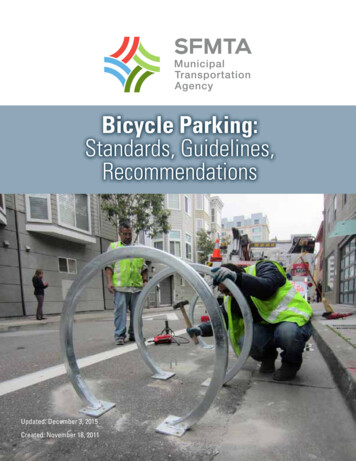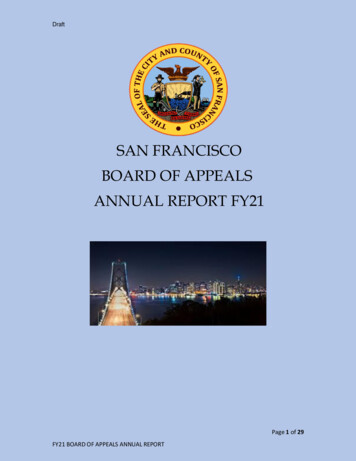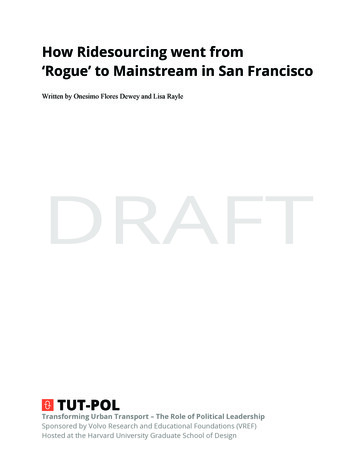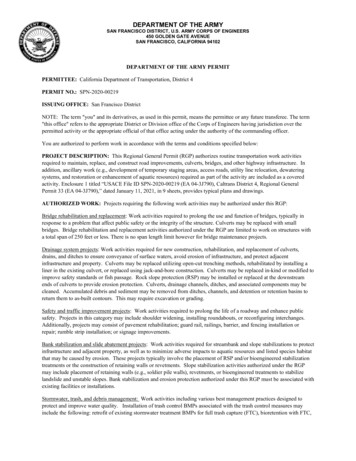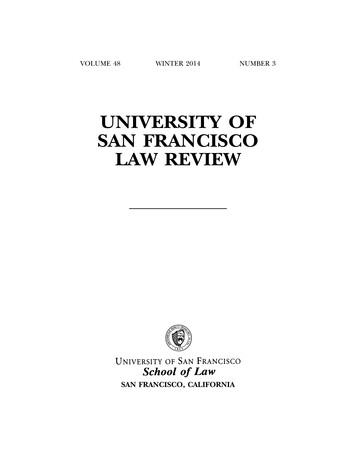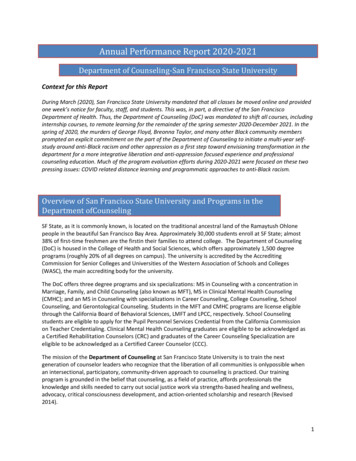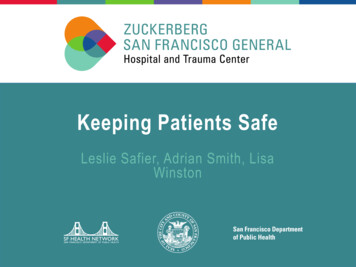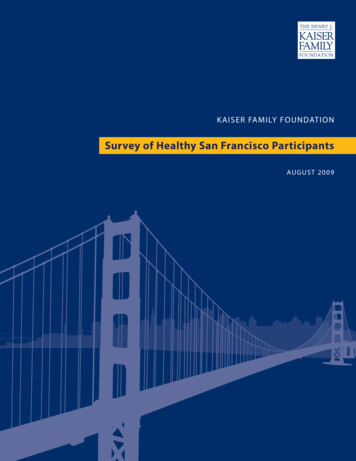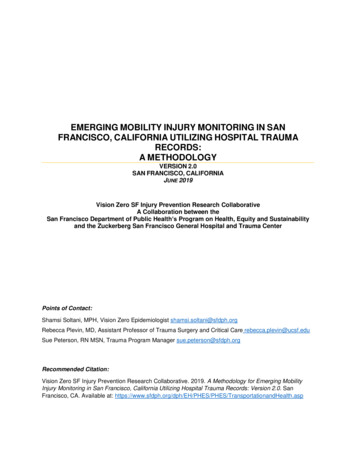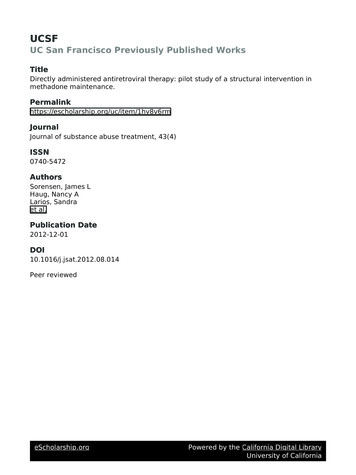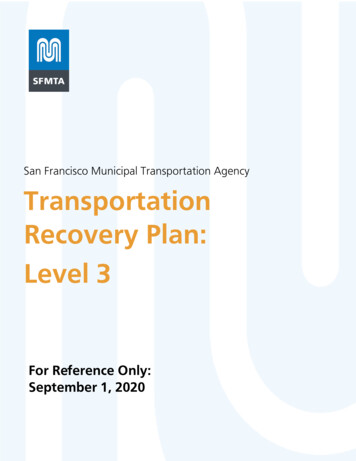
Transcription
San Francisco Municipal Transportation AgencyTransportationRecovery Plan:Level 3For Reference Only:September 1, 2020
ContentsLevel 3 . 2Overview and Conditions . 2Timeline . 3Muni Service Plan . 3Streets . 5Paratransit, Taxis & Accessible Services . 11Business Operations. 11Communications & Government Affairs. 13X.1 ThemeProvide a description of the goal of this overall theme in its particular level.X.1.1 Activity or ProgramProvide a description of the activity or program. Indicate whether there is a change to this activity or program in a particular level.X.1.1.1 WhoX.1.1.1.1 Activity or Program DetailX.1.1.1.2 Activity or Program DetailX.1.1.2 WhoX.1.1.2.1 Activity or Program DetailX.1.1.2.2 Activity or Program Detail
Transportation Recovery Plan: Level 3Level 3Anticipated Transportation DemandMuni ServiceTransit and Bicycle LanesSlow StreetsSustainable Streets OperationsParking EnforcementParking and Curb ManagementTaxi, Paratransit and AccessibilityIncrease in trips to neighborhood commercial corridors and largeinstitutional employersCore Service two additional routes and capacity increasesBegin installation of temporary treatments in critical locations andinstallation of approved bike lanesContinued expansion of Slow Streets locationsBikeshare /Scootershare resume full serviceEnforcement for street sweeping will resume; review of meter policies tosupport businessesParking garages reopen; Support Shared Spaces programTaxi customer service window reopensOverview and ConditionsLevel 3 responded to Phase 2b and 2c of San Francisco’s Reopening approach. SFMTA anticipated an amendment toPublic Health Order No. C19-07e (updated on June 1, 2020) to be released in advance of Phase 2b which had ananticipated start date of June 15, 2020. The amended public health order was anticipated to be expanded to permit thefollowing activities:BusinessChildcare and Education Outdoor fitness with physical distancing Summer camp programming with stable groups ofup to 12 All manufacturing, wholesale trade, leasing, andtransportation with over 50 employees Non-emergency medical appointments All private indoor household services Outdoor dining (restaurants and bars with food) Indoor retail Professional sports, tournaments and otherentertainment venues with no spectators Religious services and ceremonies Hair salons and barber shops* Indoor dining* Real estate open houses with appointments only** anticipated in Reopening San Francisco Phase 2c (July 13th)The SFMTA anticipated the expansion of permitted activities to result in increased demand for travel. Depending onpublic perception of effectiveness of public health/safety preventative measures on transit, it was projected that SanFrancisco would see vehicular traffic increase at a higher rate than that of transit ridership. However, SFMTA needed tocontinue to increase transit service to curb the impacts above. SFMTA bicycle and pedestrian levels were projected tomaintain and/or increase. Level 3 also assumed an increase in off-street parking demand where return to work activitieshave begun, as well as increased activity to and from commercial corridors. SFMTA needed to continue to manage SanFrancisco streets to both support the increased travel demand and accommodate modified business operations in theright of way. Therefore, the SFMTA: Increased transit frequencies and added routes to the Core Service Plan.Managed the streets to handle an increase in traffic congestion.Implemented curb management strategies to facilitate outdoor retail.Enabled street closures to support additional outdoor seating.For Reference Only - 2
Transportation Recovery Plan: Level 3The SFMTA needed to resume the following business operations in this level: Off Street parkingEnforcement of Street sweepingSome Customer ServicesTimelineBased on San Francisco’s reopening approach, SFMTA anticipated this level going into effect roughly by June 15, 2020consistent with City Phase 2b and extend through the completion of Phase 2c likely sometime late-July or Mid-August.As with all previous levels, advancement to and through level 3 was dependent on San Francisco’s progress on publichealth indicators: cases, hospital capacity, testing, contact tracing, and PPE supply.Estimated Duration: June 15 – August 22Muni Service PlanThe Level 3 Muni Service Plan built upon the service plans implemented in Level 1 and 2 and was designed to increaseservice as much as resources allow. The ability to sanitize vehicles against COVID-19 continued to be a limiting factor, aswas staff and operator resources. The primary changes to be implemented in this plan included: (1) the addition of tworoutes (2) extension of already in-service routes (3) and increased frequencies on several routes. The table belowdemonstrates the increase in service described here. The bolded elements indicate the changes/increases and representthe additional routes, increased frequencies, extensions and so on. The right-hand column summarized the change fromthe previous level for each Hours1 California (long)5 Fulton (long)7 Haight (to Funston andIrving)8 Bayshore (on Stockton)9 San Bruno9R San Bruno Rapid8 min12 min20 min8 min12 min20 PresidioPresidioWoods6 min9 min10 min5AM-10PM5AM-10PM5AM-10PMIslais Creek/FlynnWoodsWoods/NA12 Pacific community shuttle14 Mission14R Mission Rapid20 min8 min4 min8 min10 minWeekdaysOnly20 min8 min8 min5AM-10PM5AM-10PM5AM-10PMKirkland/WoodsIslais Creek/FlynnFlynn19 Polk22 Fillmore24 Divisadero25 Treasure Island28 19th Ave (DC BART toCA)29 Sunset30 Stockton38 Geary20 min8 min12 min20 min20 -10PM5AM-10PMWoodsWoodsFlynn12 min10 min8 min20 min12 min12 min20 minWeekdaysOnly20 min20 min8 minDelta fromLevel 2Full route addedAdded route(modified)IncreasedfrequencyExtended routeto CaliforniaAdded routeFor Reference Only - 3
Transportation Recovery Plan: Level Delta fromLevel 25AM-10PMWeekday/WeekendDivisionFlynn38R Geary Rapid6 min12 min43 Masonic (Munich toGeary)44 O'Shaughnessy (To ForestHill)49 Van Ness-Mission54 Felton (Bayview-BalboaPark)714 BART shuttle (bank atTransbay)L Taraval bus15 min20 min5AM-10PMKirkland/WoodsAdded route(modified)12 min15 min5AM-10PMWoods5 min20 min7 minWeekdaysOnlyWeekdaysOnly10 min5AM-10PM5AM-10PMKirkland/WoodsWoods/NA1st IB andOB trip only5AM-10PMWoods/NAM Oceanview Bus20 min5AM-10PMWoods/NA7 minWeekdaysOnly8 minN Judah bus (60's)5AM-10PMIslaisCreek/WoodsT Third bus (To Castro)6 min10 min5AM-10PMWoodsOWL14 Owl22 Owl24 Owl25 Owl38 Owl44 OwlL Owl20 Min30 min30 min30 min30 Min30 min20 min20 min30 min30 min30 min30 min30 min20 M10PM-5AMWoodsWoodsPresidioWoodsWoodsWoodsWoodsN Owl90 Owl91 Owl30 min30 min30 min30 min30 min30 min10PM-5AM10PM-5AM10PM-5AMWoodsWoodsWoodsn/a6 minWoodsIncreasedfrequencyUpsizedweekday to 60'vehicles division changeIncreasedfrequencyIncreasedfrequency3.3.1 Transit Maintenance and Support: BusSeveral maintenance and support activities were implemented to support the above service plan. Specifically, with there-introduction of 60’ articulated motor coaches, some operators of those routes required training on the 60’ vehicles.Additionally, in-field operator relief points were piloted at this level, requiring the deployment of in-field car cleaners.Maintenance of Way also needed to address any overhead catenary system (OCS) maintenance/state of good repairalong re-introduced trolley routes.3.3.1.13.3.1.1.1Transit, Transit Operations, TrainingConduct operator training on 60’ articulated motor coaches in support of level 3 serviceincreases.For Reference Only - 4
Transportation Recovery Plan: Level 33.3.1.2Transit, Bus Maintenance, Car Cleaners3.3.1.2.13.3.1.3Provide in-field car cleaning of operator compartment at piloted operator relief points along the14/14R, as resources allow.Transit, Maintenance of Way, OHLMaintenance of Way needed to support critical maintenance operations. While several trolley coach routes will be servedwith motor coaches, maintenance at targeted locations needed to take place to ensure trolley routes brought back atthis level, and subsequent levels, run safely and reliably. One such location is along the 30 Stockton southbound atStockton and Clay where there is OCS wire damage through the intersection.3.3.1.3.1Conduct critical maintenance of OCS wire and infrastructure to support the reintroduction oftrolley coach routes.Coordinate with Public Works, Bureau of Urban Forestry regarding tree trimming needs alongtrolley routes.3.3.1.3.23.3.1.4Sustainable Streets (SSD), Field Operations, Paint Shop3.3.1.4.1Refresh in-street transit stop bars and/or flag stops on existing/returning routes, as needed andresources allow.StreetsIn Level 3, SFMTA needed to further advance actions that make strategic use San Francisco’s finite right of way to enablephysical distancing and increased economic activity while simultaneously safeguarding space for transit and sustainablemodes of travel in the face of anticipated increases in traffic congestion. The strategies advanced in this level attemptedto balance these seemingly competing needs to ensure measures are in place for people get around comfortably andsafely. Strategies in this level included infrastructure-related improvements, both temporary and permanent, along withprogramming that supports shared mobility, neighborhood economic activity and curb management3.4.1 Temporary Emergency Transit LanesSince the institution of the shelter-in-place public health order, Muni has experienced travel time savings between 15 and50 percent on our routes, except where Muni Forward transit only projects had already been installed. It is imperativethat San Francisco safeguard those travel time improvements from the increase traffic congestion projected for this leveland beyond. Therefore, SFMTA sought to install emergency temporary transit lanes in order to preserve core Muni servicewhile more businesses, building and economic activities return along with related congestion.To advance emergency temporary transit lanes, SFMTA will needed to complete the 23.4.1.2.13.4.1.2.23.4.1.33.4.1.3.1SSD & Transit, Transit Engineering & Transit PlanningPrepare CEQA, legislative, and draft evaluation documents.Prepare work orders and detailed engineering plans for each potential corridor.Coordinate with the Communications team on implementing the changes & gatheringfeedback.Communications, Public Outreach and Engagement TeamPrepare and present to various stakeholder groups about the proposed lanes and corridors asthey go to Engineering Public Hearing or SFMTA Board.Assist the Transit Engineers & Service Planners in the evaluation and customer/stakeholderfeedback once the temporary lanes are installed. Work with stakeholders on makingchanges/modifications to temporary lanes.SSD, Field Operations (Sign, Paint, Meter, Temp Sign Shops)Coordinate and schedule crews for implementation of improvements.For Reference Only - 5
Transportation Recovery Plan: Level 33.4.1.3.23.4.1.3.3Install changes.Report progress and close out work orders as they are completed.3.4.2 Slow StreetsAs recovery evolves, SFMTA continued to develop the Slow Streets program to facilitate comfortable bicycling andwalking for people of all ages and abilities. In this level, SFMTA responded to the backlog of approved Slow StreetsCorridors caused by lack of materials including Type III barricades and signs. As materials arrived, SFMTA delivered theremaining approved corridors. In addition, SFMTA assessed our ability to implement new streets given current delays.Staff also continued to assess ability to respond to requests to place additional barricades at every intersection along aSlow Street. Approvals for any Slow Street expansion beyond the current map were considered on anemergency/temporary basis and will occur through EOC.The table below outlines the corridors to implemented in, and beyond this level:Date: Week of June 8, 2020o Mariposa from Kansas to Texaso 23rd Ave from Lake to Cabrilloo Golden Gate from Masonic to Brodericko Stockton from Bay to Lombard3.4.2.1SSD, Field Operations, Sign Shop3.4.2.1.13.4.2.1.23.4.2.1.33.4.2.2Date: Week of June 30, 2020o 20th Ave from Lincoln to Ortegao Jarboe from Moultrie to Peraltao Ortega from 47th Ave to 15th Aveo Kirkham from Great Highway to 18th Aveo Lombard from Jones to StocktonFabricate signs and obtain cones, A-frames, and other barriers.Place signs and barriers at intersections.Report progress and close out work orders as they are completed.SSD, Livable Streets; SSD, Other Staff (as y corridors and manage the design and implement of the program.Print Slow Streets flyers, collect COVID-19 public health informational flyers from EOC, anddeliver printed materials to Sign Shop.Send update to navigation providers.Field check barricades and monitor usage (1 visit/week).3.4.3 Shared Spaces (Previously On-Street Curb Management)The SFMTA supported an initiative identified by the City’s Economic Recovery Task Force to provide street space for theuse of local businesses for curbside pickup, physical distancing, and dining and space gathering. This initiative builds offthe processes the SFMTA has already put in place to fast-track conversion of some adjacent street parking into temporaryloading zones. Staff in Parking and Curb Management, Planning, Livable Streets, Transportation Engineering, and TransitPlanning make up a Street Closure Review Team to make sure requested locations to don’t conflict with other requestsor priorities. Staff provided program management and interagency/EOC/DOC coordination.The table below outlines the goals, strategies and tools for the initiative.GoalsStrategiesToolsPromote public healthooooProvide space for people to shop safelyProvide space for people to walk and bike ata safe distance from shoppers and dinersProvide space for people to congregate andmingle safelyCurbside pickup zones: restrict on-streetparking at or near businesses to allowcustomers and delivery drivers to pick uporders for food or other goodsFor Reference Only - 6
Transportation Recovery Plan: Level 3GoalsStrategiesToolsSupport local businessesooooPromote traffic safetyand prevent congestionoFacilitate curbside pickupProvide space for restaurants and bars toexpand their dining and gathering areasProvide space for safe queueingFacilitate pickups at the curb rather than inthe transit/bike/travel laneoCurbside physical distancing zones: restrictparking at the entrances to businesses thatregularly have queues at the entrance, toallow passersby to pass at a safe distanceOutdoor dining/gathering zones at the curbor in the street: allocate public space forrestaurants or bars to effectively expandtheir space to serve customers at a safedistanceThis City piloted two locations: (1) Valencia (between 15th St. and 19th St); and (2) outside a business location near Fillmoreand Greenwich. The table below indicates the types of space and outlines rough plans for the permitting process, whichwill be further refined in collaboration with City partners and the EOC.Type ofSpaceSiteIdentifierPermit ProcessReview andapprovalAppeal processNone - selfcertifiedNoneSFMTA - 1-3 usinessOwnerCity provides basic guidelines for safe use of sidewalk(must keep clear path of travel, etc.). Any restaurant canfill out an application, self-certify that they're incompliance, and begin use immediately. Complianceverified by inspections as needed.Handled similarly to current loading zone initiativebusiness owner submits application for use of curbsidelane for tables and chairs or parklet type use. Incentivizeneighboring businesses to apply together for longerparklets. SFMTA staff very quickly reviews for any designor operational conflicts. If approved, SFMTA sets upbarriers to separate dining from traffic lanes.SFMTASFMTA staff to proactively identify blocks that will begood candidates for partial and full closures. Willcontact restaurants and merchant groups in the vicinityand invite them to submit an application to City.Applications should encourage collaboration betweenneighboring businesses as much as possible - a streetclosure affects everyone on the block. Restaurants andgroups that the SFMTA did not identify may still applyfor consideration.SFMTA - butmost blocks prevettedDepartmentthat hasjurisdictionREC/RED/MTA/PRT/PLN to proactively identify Citycontrolled public open space under the jurisdiction oftheir department that is adjacent to restaurant uses thatmight be appropriate for outdoor dining. The citydepartments will contact restaurants and groups andinvite them to apply for temporary use.REC/RED/MTA/PRT - butsites pre-vettedPartial/FullStreetClosurePlaza,Parking Lot,Park, PortNotice sentout/posted at least5 days ahead ofclosure. Appealswill be heard byhearingofficer/programmanager at SFMTA.Notice sentout/posted at least5 days ahead ofclosure. Appealswill be heard byhearingofficer/programmanager at RED.For Reference Only - 7
Transportation Recovery Plan: Level 33.4.3.1SSD, Parking and Curb Management, Planning, Livable Streets, .13.4.3.43.4.3.4.13.4.3.4.2Staff Street Closure Review Team and provide detailed reviews and recommendations whenstreet closure requests are made.Provide program management support in coordination with City Partners.Provide program management support and liaise with the EOC.SSD, Field Operations, Temporary Sign Shop, Paint ShopPrepare and Install signage as needed to support curbside management demands.Paint new white and yellow zones, as needed.Report progress and close out work orders as they are completed.SSD, Security, Investigation and Enforcement, Parking EnforcementEnforce closures as resources allow.Transit, Transit PlanningStaff Street Closure Review Team and provide detailed reviews and recommendations whenstreet closure requests are made.Support review of requests against priority transit corridors/transit needs.3.4.4 Shared Mobility: Bikeshare Expansion & Bike ParkingWhile commute volumes were still lower than pre-pandemic, reduced transit services and general public caution awayfrom enclosed vehicles. This could lead to significant mode shift to bikes and scooters, translating into more trips forbikeshare. The benefits of shared mobility such as eliminating primary user concerns for maintenance, security, andconvenience, coupled with other bike/pedestrian infrastructure safety improvements, mean shared mobility is uniquelypositioned to offer affordable near-term alternative travel solutions and affect significant mode shift.Two key programmatic efforts needed to move forward at this level: (1) focus on rapid permitting and construction ofnew station locations (SFMTA needed to permit and install bikeshare stations at a faster pace to expand from SanFrancisco’s existing stations toward a complete build out of 320); and (2) prioritize implementation of bike racks toprovide places to respond to increased biking and the deployment of shared-mobility 23.4.4.43.4.4.4.1SSD, Livable Streets, Bikeshare TeamModify and implement outreach strategies with key stakeholders including but not limited toBOS, advocacy groups, merchant associations and general public.Continue to promote Baywheels free membership for essential work.Rapidly review, legislate, and permit new stations.Fund SF Public Works permit review and approval of station permits.Collaborate with SF Police Department and Department of Homelessness on station protectionstandards.SSD, Transportation Engineering, Public HearingsPost hearing notices, prepare packets and deliver virtual Public Hearings.SSD, Livable Streets, Bike Parking TeamDraft work orders to install of bike racks to provide places to park and deploy devices.Finalize design and implementation guidelines for on-street bike parking corrals.SSD, Transportation Engineering, Traffic RoutingReview and approve Special Traffic Permits (STPs) and Traffic Control Plans (TCPs).For Reference Only - 8
Transportation Recovery Plan: Level 33.4.4.53.4.4.5.13.4.4.5.2SSD, Field Operations, Sign ShopInstall bike racks and bike parking corrals.Report progress and close out work orders as they are completed.3.4.5 Shared Mobility: ScootershareAs noted above, shared mobility such as scootershare has a critical role to play in curbing traffic congestion and ensuringthe availability of near-term alternative travel solutions. In this leve,l SFMTA needed to coordinate with shared mobilityoperators to eliminate primary user concerns around maintenance, security, and convenience. Additionally, the SFMTAdrafted a new policy document that sets standards for the following three things:3.4.5.13.4.5.1.13.4.5.1.23.4.5.1.3Taxi and Accessible Services, Permitted Mobility TeamUpdate maintenance, cleaning, and operational procedures to ensure that they’re following thelatest CDC/COVID guidance (something similar to what we’ve supplied the taxis).Update the metrics for network monitoring cleanliness but also for evaluating performance andmaking changes quickly to anticipate the evolution of the COVID pandemic response.Initiate development of distribution plan for proper deployment and redeployment of scootersas demand changes over time.3.4.6 Implementation of Permanently Legislated Transit-Only Lanes and BikewaysWith restrictions on construction activities partially lifted as per Public Health Order No. C19-07c, certain constructionactivities continued at this level. SSD Traffic Routing staff continued to review and approve Special Traffic Permits (STPs)and Traffic Control Plans (TCPs) related to increased construction activity allowed in this level.In order to implement this program, we needed the 13.4.6.4.23.4.6.4.3SSD, Transportation Engineering, Traffic RoutingReview and approve Special Traffic Permits (STPs) and Traffic Control Plans (TCPs).SSD, Livable Streets, Transportation Engineering; Transit, Transit PlanningDraft design proposals, circulate through review processes (including TASC and ERT), andfinalize designs.Prepare work orders and detailed engineering plans for each potential corridor.Inform JIC, MYR, and Supervisors of upcoming implementation.Coordinate with the Communications team on implementing the changes & gathering feedbackCommunications, Public Outreach and EngagementConduct outreach to communities as the project gets close to implementation.SSD, Field Operations (all)Coordinate and schedule crews for installation of improvements.Install changes.Report progress and close out work orders as they are completed.3.4.7 On-Street Parking and EnforcementParking enforcement will likely not be fully reinstated until the shelter-in-place is lifted, later in Level 4 or 5. However inpreparation of bringing enforcement back, the Parking and Curb Management team needed to determine whether anymodifications to peak hour zones and or other policies should be made. Additionally, public notifications warning of theupcoming reinstatement needed to take place at this level. In subsequent levels enforcement staff will begin to return towork and enforcement will be phased as follows (1) enforcement of street cleaning, (2) meter enforcement, (3) RPPenforcement.For Reference Only - 9
Transportation Recovery Plan: Level 3Street SweepingShelter-in-place guidelines do not prevent most residents from moving their vehicles for street cleaning, therefore streetsweeping enforcement was reinstated at this level. Citations should be dismissed only with evidence submitted from ahealth care provider that their medical condition prevented individuals from leaving their home. Starting in June, streetcleaning resumed and required more parking enforcement. Frequency of street cleaning is different in different parts ofthe city; from daily, weekly, biweekly (1st and 3rd or 2nd and 4th) and some monthly. SFMTA needed to issue warningnotices to vehicles in the street cleaning zones. The below table outlines the staffing requirements for initial restart ofstreet cleaning.AssignmentDaytime Street CleaningMidnight Street CleaningService Requests (587/588)DSW Assignment MON-FRIDSW Assignment MON-SUNTotalWeekly Assignment Total3507511415584778PCO’s Needed7015233117156Parking Enforcement staffing was currently 115. The team anticipated 244 staff returning beginning of June. Pendingthe return of staff, Parking Enforcement anticipated being sufficiently staff to cover assignments. The below outlines thestart-up schedule for warning and enforcement which began in mid-June.Warning:Enforcement:Week of June 15, 2020Warnings for Daily, Weekly Zones and Bi-weekly Zones (1st No Enforcement& 3rd)Week of June 22, 2020:Warnings for Bi-Weekly Zones (2nd & 4th)Enforce Daily and Weekly ZonesWeek of June 29, 2020:Enforce Daily, Weekly and Bi-Weekly Zones (1st and 3rd) NoEnforcement on June 29th or 30th – these dates are 5thweek no enforcement.Week of July 6, 2020:No WarningsEnforce Daily, Weekly Zones and Bi-Weekly Zones (1st andJuly6thand7th)3rdndththth(2 and 4 – July 8 to July 10 )Week of July 13, 2020:No WarningsNormal Schedule ResumesAs outlined above, SFMTA anticipated street sweeping to be the first of the suspended parking regulations to resume,with the activities below needing to take place to 1.43.4.7.1.5SSD, Security, Investigation and Enforcement, Parking EnforcementPrepare to resume enforcement of street sweeping regulations in Mid-June.Prioritize enforcement of fire hydrant zones; "No Stopping" or "No Parking" zones; color curbblocked driveways; double parking; parking on sidewalks; parking in bike or transit lanes.Enforce of temporary tow away zones and request SFPD to call vehicle owners in lieu of towing.Prepare for reinstatement of meter enforcement on June 8th.Begin warning activities regarding reinstatement of enforcement as progress is made towardsLevel three is made.For Reference Only - 10
Transportation Recovery Plan: Level 33.4.7.2FIT, Revenue Collections and Sales, Customer Service Center3.4.7.2.1Extend the contesting period until the DOC can reopen the Customer Service Center.3.4.8 Tenderloin Neighborhood PlanIn Level 3, the SFMTA continued to actively support the Tenderloin Neighborhood Plan for COVID-19, which is led by theHealthy Streets Operations Center (HSOC) and includes recommendations on how to deliver essential services to acommunity that faces unique social adversities and structural barriers to reasonably shelter in place. Therecommendations are further specified for 13 high priority city blocks, some of which require support from the SFMTAto execute. While the plan comprehensively covers many aspects of providing resources to the Tenderloin, the SFMTA ismost involved with closing streets and parking to facilitate safe travel in the neighborhood and activating open spacesfor family recreation.In order to support the Tenderloin Plan, we needed to do the following:3.4.8.1SSD, Parking and Curb Management3.4.8.1.13.4.8.2Receive, review and process closure requests.SSD, Field Operations, Sign Shop3.4.8.2.13.4.8.2.23.4.8.2.33.4.8.3Fabricate signs for temporary travel lane and/or parking lane closures.Install temporary signage and adjust as needed.Report progress and close out work orders as they are completed.SSD, Security, Investigation and Enforcement, Parking Enforcement3.4.8.3.1Support enforcement of temporary tow-away zones.Paratransit, Taxis & Accessible ServicesParatransit and taxi service continued to operate the ETC and Shop-a-Round Programs as implemented in Level 1 andLevel 2. Taxis and Accessible Services staff continued to monitor on-demand paratransit services and asses available fleetto meet request. As requests increased, vehicles and operators needed to be pulled from EOC related assignments tofulfill demand.3.5.1.1Taxi and Accessible Services, Accessible Services3.5.1.1.13.5.1.1.2Continue to operate ETC and Shop-a-Round Programs.Monitor on-demand requests and identify strategy to return services.Business OperationsBusiness Operations outlined in Level 1 and 2 continued into level 3. These activities include: internal committees, TASC,ISCOTT, Public Hearings, Board of Directors Meetings, and RPP Check Cashing. The below activities were needed tosupport strategies outline above as well as the transportation demands anticipated in this level.3.6.1 Customer ServiceIn Level 1 and Level 2, most customer service locations (except the Paratransit Office) were clo
Transportation Recovery Plan: Level 3 . 3.3.1.2 Transit, Bus . Maintenance, Car Cleaners . 3.3.1.2.1 Provide in-field car cl eaning of operator compartment at piloted operator relie f points along the 14/14R, as resources allow. 3.3.1.3 Transit, Maintenance of Way, OHL . Maintenance of Way needed to support critical maintenance operatio ns.
